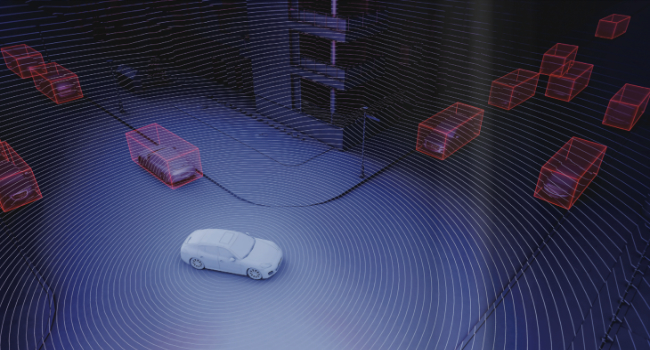
To the Next Level
- By Teresa Liou
- Feb 03, 2021
Security and surveillance solutions must be able to quickly, accurately and reliably identify potential threats so that security staff can promptly respond. Sensitive areas like critical infrastructure and other limited access locations require advanced security capabilities with a low rate of false alarms, which waste valuable time and can slow down response times for real threats. However, traditional security technologies like cameras and motion sensors alone often cannot meet the strictest security requirements and performance.
Combining Technologies to Achieve Better Outcomes
LiDAR (Light, Detection, and Ranging) is a time-of-flight sensing technology that pulses low-power, eye-safe lasers. LiDAR sensors measure the distance between the sensor and objects based on the light reflections off those objects. The resulting data is used to generate a centimeter-level accurate 3D point cloud image and provides spatial location information to detect and track moving targets like intruders. LiDAR sensors perform reliably in various weather conditions, as well as in both very bright and extremely dark conditions.
When integrated with cameras and VMS, LiDAR technology enhances security functionality and reliability by allowing for real-time intruder tracking and visualization as well as enabling automated PTZ camera control due to its high accuracy object positioning capability. In essence, LiDAR systems complement and drive more effective usage of available security cameras.
5 Benefits of LiDAR for Security
LiDAR provides many benefits over competing technologies, including high accuracy, cost savings, real-time tracking and analysis, seamless integration with existing infrastructure, and simple system management. The LiDAR-based security and surveillance solution provides numerous important benefits for the recent security application.
High accuracy, even in adverse conditions. LiDAR offers a superior level of accuracy compared to alternative technologies. In the recent security application described above, the LiDAR solution boasted 95% accuracy. In addition, LiDAR sensors maintain their reliability and high performance even in extremely bright or low light conditions, and in adverse weather like wind or rain.
Low rate of false alarms. The intelligence and reliability of a LiDAR-based solution significantly reduces the rate of false alarms in security applications, ultimately saving time and costs. Customers have experienced a reduction of false alarms by up to 84% compared to using cameras alone. The low rate of false alarms provides security personnel with confidence in the reliability of the alerts, improving the quality and promptness of their responses.
Easy-to-manage, fully automated solution. Some LiDAR-based surveillance solutions use machine learning and 3D perception algorithms to scan the sensor’s field of view, analyze point cloud data, and provide metadata on detected individuals. Intruder location information from the LiDAR system can be used to automate PTZ camera movement so that intruders are detected and tracked visually from the moment of trespass. This fully automated security solution is both cost-effective and easy to manage.
Real-time tracking and analysis. With a LiDAR-based solution, security data is available in real time. The solution automatically tracks individual people and provides real-time location information, enabling security staff to quickly locate and respond to potential threats.
Cost-effective Deployment. In addition to unparalleled levels of accuracy, a LiDAR-based solution is also extremely cost-effective. Some LiDAR sensors can provide a 360-degree field of view, which means far more area can be covered with each device compared to other sensing technologies. With fewer devices to install and maintain, a LiDAR-based system saves time and costs.
LiDAR-based Security Use Case: Port Security
For example, in a recent security application, a port in South Korea needed to upgrade its security systems to improve security and reduce false alarms. The port’s existing camera-based systems and traditional intrusion prevention technology did not provide the necessary awareness to protect critical security facilities. A more accurate and intelligent solution was needed to reliably identify and respond to potential threats. In addition, the port required a fully automated surveillance solution with a low rate of false alarms that could deliver consistent results regardless of environmental conditions. Furthermore, the solution needed to integrate effectively with their existing systems.
Port authorities had used several different perimeter security technologies in their challenging outdoor conditions, including CCTV, infrared sensors, and tension sensors. However, these technologies were unable to maintain the extremely high levels of accuracy that the application required, and environmental factors like wind and rain caused frequent security failures. False alarms were especially costly, wasting valuable time and resources to respond to nonexistent threats.
Port authorities ultimately selected a highly intelligent and combined hardware and software platform solution consisting of PTZ cameras and LiDAR sensors with artificial intelligence perception software. The LiDAR based solution provided 95% accuracy and a complete 360-degree view of the secured area in any light or weather condition with the ability to detect, track, and classify objects based on the rich point cloud data received from the LiDAR sensors. The solution integrated effectively with the customer’s existing systems, including their VMS. The solution also included a dashboard for at-a-glance visibility into all regions where LiDAR sensors are installed.
As technology advances, security and surveillance must keep pace to reduce false alarms and improve the protection of sensitive areas. Cameras will always play an important role in any physical security strategy. But adding LiDAR technology provides an extra layer of protection while empowering security personnel to do their jobs more effectively.
This article originally appeared in the January / February 2021 issue of Security Today.